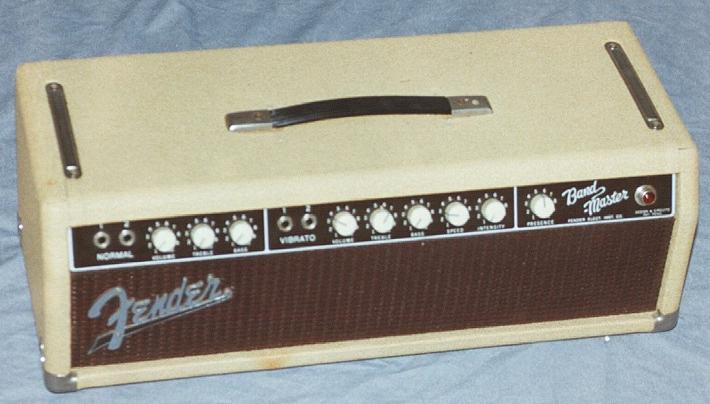
FACTOIDS & TRIVIA
The Fender Bandmaster evolved from a 1x15 combo in the early '50s to a 3x10 combo in the mid to late 1950s. In 1960, the vertical chassis, tweed covered Bandmaster gave way to a horizontal chassis, Tolex covered Bandmaster. The model (6G7) retained the 3x10 speaker configuration, but had a completely different circuit than the tweed versions. The 3x10 Tolex Bandmaster was very short lived and by late 1960 the amp received an updated tremolo circuit and was produced as a piggyback amp with separate head and speaker cabinet instead of a combo amp (model 6G7-A). The earliest 6G7-A Bandmasters used the same 8 ohm output transformer as the brown Pro Amp since the speaker cabinet had a single 8-ohm 12 inch speaker. The 1x12 cabinet used a double baffle ported reflex design. The Bandmaster shown here is an 8 ohm unit, but finding a matching 1x12 cabinet has been nearly impossible. By late, 1961 Fender dropped the 1x12 ported cabinet in favor of the 2x12 infinite baffle (sealed) enclosure as used on the blonde 6G9-A and 6G9-B Bassman amps. The output transformer was, naturally, changed to 4-ohm unit with the change to the 4-ohm 2x12 cabinet. It is interesting to note that the Concert, Bandmaster, and Pro all have nearly identical circuits. The major difference is in the output transformer and speaker configuration.
FENDER BANDMASTER AMP 6G7-A (1961)

Power Amp: Tube; 2 x 5881, 40 watts RMS @ 8 ohms
Preamp: Tube; 3 x 12AX7, 3 x 7025
Rectifier: Solid state; silicon diode
Channels: 2 (Normal, Vibrato); 2 inputs per channel
Effects: Tremolo
Controls: Normal - volume, bass, treble; Vibrato - volume, bass, treble, tremolo intensity, tremolo depth, presence; foot switch for tremolo
Dimensions: 8 1/2 H x 24 W x 9 D inches
Total Weight: n/a
Back
to the Fender Amp Pix Menu